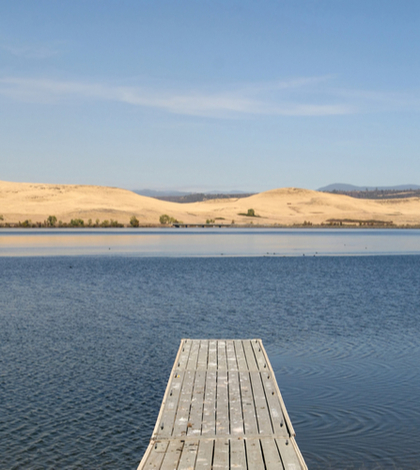While work for the repair and reconstruction of the main Lake Oroville spillway continues, the Department of Water Resources (DWR) has released the operations plan for Lake Oroville during the upcoming 2017-18 rainy season. The plan is focused on protecting public safety and directs DWR to intentionally maintain lower-than-average lake levels during the winter months thereby providing space for inflows and the ability to manage releases from the partially reconstructed main spillway.
“This plan puts public safety first, while also meeting our water supply and environmental obligations as we repair and rebuild the Lake Oroville spillways,” said DWR Director Grant Davis. “We will operate Lake Oroville conservatively until construction on both spillways is complete in late 2018, early 2019.”
Davis’s reference to conservative operations at Lake Oroville will have DWR lower the lake level to an elevation of 700 feet by November 1, versus the average 780 feet elevation maintained on that date in prior years, as per the new operations plan. Lowering the lake level will allow for more than 2.2 million acre-feet of flood water reserve storage to accommodate inflows during the rainy season.
Lake Oroville’s main spillway was heavily damaged on February 7, during unprecedented rainfall due to atmospheric storms which stalled over the Butte County area. To relieve some of the pressure mounting in Lake Oroville, the state released water down the main spillway at rates of up to 54,500 cubic feet per second (cfs). Operators soon noticed a small crack in the lower portion of the spillway which rapidly grew to a 250-foot crater.
Concerns over the spillway fissure mounted in the city of Oroville and the surrounding towns that the dam could fail completely and flood the downstream communities. Although officials shut off water to the main spillway, the ongoing rains continued to refill Lake Oroville. According to Joel Ledesma, one of the incident commanders during the prolonged disaster – when speaking to attendees at the August 11 San Bernardino County (SBC) Water Conference — downstream evacuation of homes and businesses displaced some 200,000 people for several days but was clearly necessary for public safety.
Ultimately officials opted to try releasing water down the earthen emergency spillway, adjacent to the main spillway on Feb. 12; the water began to erode the hillside and officials determined that the erosion was threatening to undercut the entire dam. To mitigate the growing danger in using the emergency spillway, officials opted to release an additional 100,000 cfs of water down the main chute, resulting in further spillway damage. Luckily, the dam held and as the rains receded the reservoir ultimately dropped below 850 feet.
The new Lake Oroville operations plan calls for DWR to lower the lake level to an elevation of 700 feet by November 1 versus the average 780 feet elevation maintained on that date in prior years. This will allow for more than 2.2 million acre-feet of flood reserve storage to accommodate inflows during the rainy season. The lower lake level along with combined operational contingencies, should allow DWR to keep releases from the mostly reconstructed main spillway at 100,000 cubic-feet per second (cfs) or less throughout the rainy season and ensure lake levels remain below 901 feet. Keeping the lake levels below 901 feet would negate use of the emergency spillway which is also still undergoing construction.
Within the next two weeks work on the main spillway will be prepared to handle releases of up to 100,000 cfs. Work to repair and reconstruct the main spillway has been underway since April and is expected to be completed by Nov. 1. By next season, it will be fully reconstructed to handle the original design capacity of 270,000 cfs. Releases from the main spillway have never been above 160,000 cfs. Once the full construction of Lake Oroville’s main and emergency spillways is completed in early 2019, DWR and the U.S. Army Corps of Engineers plan to begin working on a long-term operations plan, which will involve extensive public input.
 California Water News Daily Your Source For Water News in California
California Water News Daily Your Source For Water News in California


